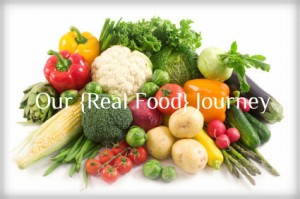If you’re new to this series, start here!
The most common argument against buying real food is the cost, and hopefully offering up 12 Ways to Save makes that argument a little less viable! I do think saving money where we can is important; however, I’d also like to challenge the western thought process toward food in relationship to our money AND time!
Is Buying Organic Essential to a Real Food kitchen?
Let me start by saying: real, whole foods always win out over the fake stuff! Conventionally grown apples are indeed nutritionally superior to potato chips! However, if a {Real Food} item is laced with pesticides, herbicides, dyes, growth hormones, antibiotics, etc. then it is really just an adulterated version of its real food self!
A while back I read this article, which speaks volumes to how even things one might consider “real” is corrupted, such as: corn-fed beef, canned tomatoes, conventional potatoes and apples. Or, use this chart to compare the nutrients received from conventional vs. organically grown vegetables. The difference is shocking! If you’re looking to decrease the toxicity and increase the nutritional value of your food, consider buying certain items organic/grass-fed/pastured!
Real Food is Actually Cheaper!
Most people argue that healthy food costs more; however, Real Food is actually cheaper when accounting for price per unit of weight and price per serving, not to mention the nutrients that our bodies receive and the avoidance of future medical bills (for which American’s annually pay BILLIONS of dollars, much of that on hospital stays and medication for diet-related health problems)!
The consumption of unnaturally dense foods is the main cause for the epidemic of obesity in America…what’s happening is that [people’s] mechanisms of satiation are being fooled…For instance 500 calories of natural plant food fills the stomach completely; triggering both our stretch and our density receptors to signal our brain that we’ve had enough to eat. But 500 calories of unnaturally rich or processed foods fills the stomach far less, deceiving these receptors into telling our brain that we need to eat more; even worse is that 500 calories of oil (which is almost pure fat) and barely triggers any response at all. – Forks Over Knives (Documentary).
In addition, USDA research recently reported:
In contrast with the conventional wisdom that healthy food costs too much…For all metrics except the price of food energy, the authors find that healthy foods cost less than less healthy foods. “Often, less-healthy food options are made up of empty calories, prompting people to eat even more,” said Andrea Carlson, lead researcher of the report. “Take a chocolate glazed donut which is 240 calories,” she said. “You can easily eat one, if not two or three without any trouble at all. However, a banana, which has a lot of nutrients in it and will make you feel quite full, has only 105 calories. You will feel fuller if you eat the banana versus the donut.” – source
I can guarantee that, initially, one will feel less “satisfied” from eating the banana because our bodies have been so inundated with sugar and MSG that our brain is telling us we are still hungry, need more, and that chocolate donut would hit the spot! But, as a vote of confidence, give it just a little time and your body will soon crave the healthy and life-giving nutrients vs. the deceitful and depleting sugar and trans-fats.
What are our Spending Priorities?
Food is absolutely essential for life; why then are we so hesitant and angry to spend money on it? It not only offers our bodies vital nutrients to stay alive (at the very least) but what we do or don’t eat also has the power to promote high energy-levels, good sleep habits, vitality and youthfulness, while curbing common ailments like depression, auto-immune disorders, childhood diagnoses, persistent weight gain (or lack of loss), skin & sleep problems etc. It should be a well-known fact that American’s spend the lowest percentage of income on food than any other people group in the world!
We’ve gotten so good at producing calories efficiently, in fact, that our problem is no longer that we can’t afford enough food—it’s that the types of calories that are least expensive are the ones that are worst for us…As Michael Pollan, Marion Nestle, and others who study our food system have pointed out, food is as cheap as it is because the true costs have been externalized – that is, we pay for them in rising obesity rates, environmental degradation, lax safety measures, and disgraceful labor practices. And if you count the money taxpayers send Big Ag in subsidies—around $261.9 billion between 1995 and 2010—cheap food starts to seem like it might not be such a bargain after all. (source)
Creating a Food Culture: Let’s Invest our Time and Money!
Growing up I didn’t really learn my way around a kitchen; when I left the house and cooking/eating was up to me, I often viewed it as a waste of time or something that kept me from what I’d rather be doing. As a nation, we’ve grown accustomed to wanting little or nothing to do with our food, whether it is growing, cooking, preparing, serving, hosting or even the enjoyment of eating it! I have fallen in love with the notion of traditional food cultures, those of other countries and even traditional “American” diets (which really were the diets of the countries we originated).
Food in other places is a MAJOR part of the day: shopping for it, preparing it and eating it TOGETHER!
In our busy culture, some days, time in the kitchen is just not possible. But statistically, Americans have 5-6 hours of leisure time per day (this is in addition to what we spend on household chores, which includes cooking) and spend an average of about 3 hours watching television. If instead, we looked to meal planning and preparation as less of a chore and more of a leisure activity, we’d suddenly feel like we had a couple more hours in the day!
If you consider Maslow’s Hierarchy of Needs, it makes sense that our absolute most basic physiological needs are breath, food, water, etc. Our next greatest needs are for Safety and Love/Belonging! Gathering together around the dinner table not only supplies us with physical nourishment, but that which we all desire, the nourishment of deep relationship.
In this sense, it might feel like it costs more, but investing time and money in real food is a remarkable blessing to ourselves and our families and is even a leisurely act of artistic expression!
I’m wrapping up this series tomorrow with a little encouragement and a list of my favorite resources. I’d love to answer any additional questions!
Becca V
Latest posts by Becca V (see all)
- My New Favorite Carseat - September 16, 2016
- Quick Lit: April 2015 - April 15, 2015
- How’s It Going? - February 24, 2015








This is so great Bec! I was actually going to comment on your last post that just thinking of what processed food costs, you save a ton of $ not buying it and making your own! Sure, I had a few heart palpitations spending $8 on coconut oil for granola, but it is going to last a while. That’s how much it costs to buy like 2 boxes of cereal; something I would have previously considered ‘healthy’. Oh, so much to say! I’ll just leave it at, agreed!
Becca, fantastic job. I love reading this and had no idea this was a project you’ve been working on (in your “spare” time :)). You keep posting and I’ll keep reading :) Nice work!
Thank you so much, Sarah!
Glad you had time to post on how real food is actually cheaper – NYT and WAPO just did articles on the same. Hopefully people realize it, especially those who claim interest from a social justice standpoint.
I have been on a real food journey as well. The Weston A. Price Foundation (westonaprice.org) has been instrumental in helping me discover the benefits of traditional foods. Glad to know there are others learning the same principles from other sources. Thanks for sharing so much on this topic, Becca!
YES! I’ve read a lot of his research and almost every single one of the books I’ve read has cited some of Price’s work. I will add it to the list! Thanks for reading, Kaitlyn! It is awesome to know we’re all doing this together :)